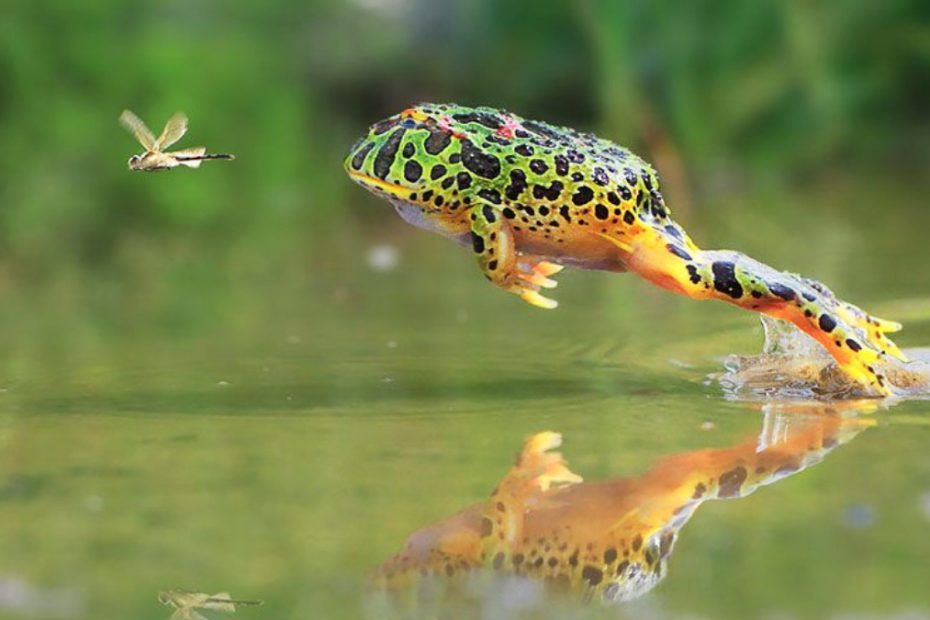One of the many fascinating behaviors of frogs is their unique ability to take big leaps! One of the benefits of this unique adaption is to help them easily escape predators. But how high or far can these amphibians jump?
How high and far can a frog jump? How high or far a frog jumps usually depends on the species, age, and size of the frog. On average, most frogs can jump 30 to 50 times their body length, with some species going even further than this. The amphibians can also jump up to 2x higher than their body height.
In our article below, we will give you the exact statistics regarding how various species of frogs can jump. We will also discuss other related questions you need to know about this intriguing frog’s behavior.
How High and Far Can a Frog Jump?
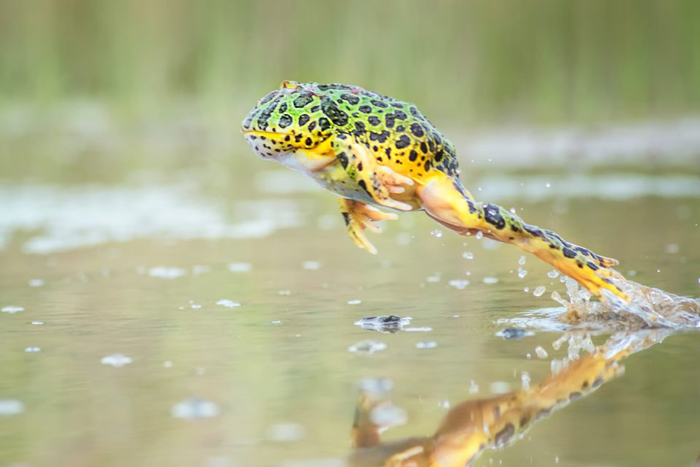
This table shows the approximate jumping distances in feet, inches, and meters for some of the most common frog species:
| Frog species | Jumping distance (feet) | Jumping distance (inches) | Jumping distance (meters) |
|---|---|---|---|
| American bullfrog | 6 ft | 72 inches | 1.8 meters |
| Green tree frog | 4 to 5 ft | 48 to 60 inches | 1.2 meters |
| Cuban tree frog | 6 ft. | 72 inches | 1.8 meters |
| Red-eyed tree frog | 5+ feet | 60 inches | 1.5 meters |
| Northern leopard frog | 3ft. | 36 inches | 0.9 meters |
| Cricket frog | 3 to 6 ft. | 36 to 72 inches | 0.9 to 1.8 meters |
| South African sharp-nosed frog | 10.8 ft. | 130 inches | 3.3meters |
How high can a frog jump?
How high a frog can jump usually depends on the species. Generally, most frogs can jump at least 2 times their own height. Tree frogs have proved to be some of the highest jumpers and can go as high as 10x their height.
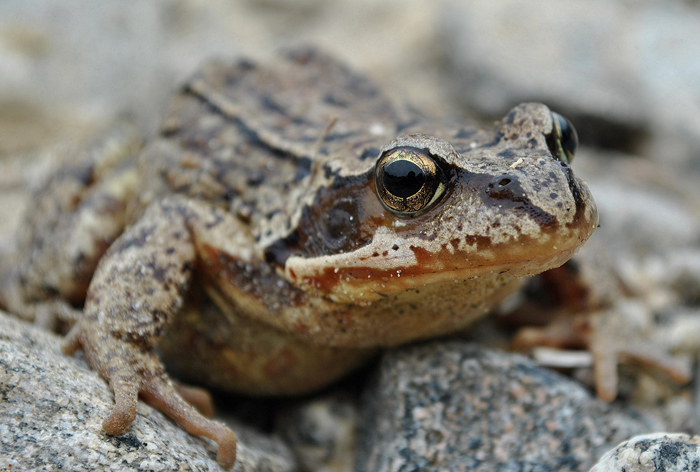
However, it is not clear how high they jump. Biologists know the frogs better by how far (or the length) they can jump and how high they can go. That’s why there’s limited info on how high they can jump.
However, we can all agree that frogs generally have smaller bodies, which means they can easily jump to high heights. So, don’t be surprised if you see a frog jump so high—up to 10x its body height!
Let’s discuss how far frogs can jump in our next section.
How far can a frog jump?
As we said earlier how far a frog can jump depends on the species. The size and age of a frog can also affect how far it can jump.
Generally, mammy frog species have been observed jumping at least 30 times their body length. Small frog species can jump even farther; up to 50 times their body length.
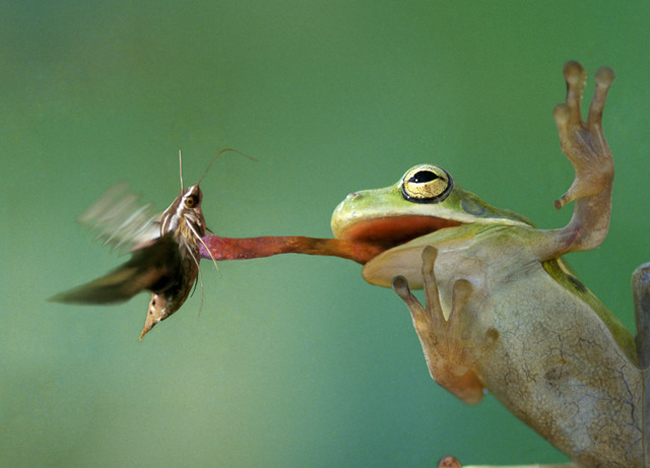
Even more surprising is that some frogs like the Wallace’s flying frog, which belongs to the family Rhacophorus are capable of flying and gliding at even longer distances compared to the ones we’ve just mentioned above.
What makes these frogs special? It’s simple; they feature webbed feet which they utilize as a parachute to enable them to glide from one spot to another as well as slow down their fall so they do not sustain injuries from landing impact. Quite fascinating, right?!
FUN FACT: The South African sharp-nosed frog holds the world record for the longest jump. Despite being relatively small (only 3 inches long), it can jump up to 44x its body length, which translates to a whopping 130 inches in just one leap!
How does a frog jump?
You may have heard that frogs can jump because they have powerful hind legs or simply strong leg muscles. But this isn’t 100% true. The secret of these amphibians taking giant leaps lies in their tendons.
When any frog prepares to take a jump, its tendons simply stretch out as much as they possibly can. At the same time, the frog’s leg muscles shorten to transfer energy to the tendons.
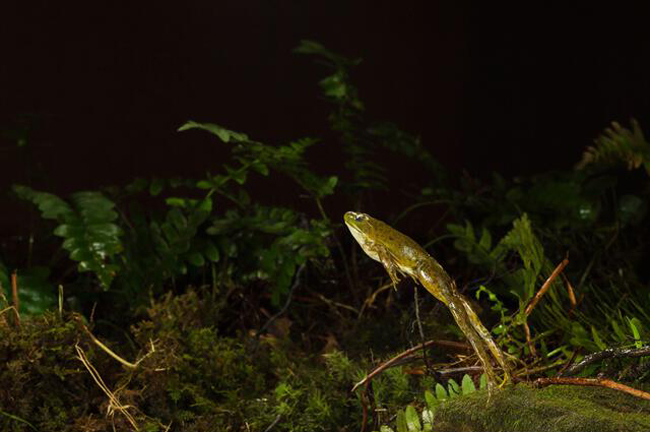
Following this energy transfer, the tendons stretch and the frog takes flight from one point to another. After landing, the tendons then recoil, just like a spring does. This flexibility is what fuels the frogs to jump to those incredibly far distances.
The discovery that frogs use their spring-like tendons to jump as high and as far as they can was made by researcher Henry Astley, following his study on the biomechanics of frog jumping at Brown University. (Source).
In finding out the truth about the frog’s superior jumping capabilities, he and his colleagues filed a frog at 500 fps (frames per second) so they could have a vivid picture of how the amphibian jumps.
Additionally, they filmed the frogs using X-ray cameras and discovered that the tendons played a crucial role in propelling the frogs’ jumps.
The video below shows how the tendons react when a frog jumps as filmed by Henry Astley
Video:
Why do frogs jump instead of walk?
The reason frogs hop and not walk is to enable them to quickly get away from their predators, as they can leap away in a split second. They also need to jump quickly to catch their prey which moves faster in their natural habitats.
Frogs jumping is also an adaptation to enable them to move around in their natural habitats. Most frog species live in wetlands and marshy conditions, where walking or running may be less efficient due to the softness and unevenness of these terrains.
Moreover, jumping makes it easy for these frogs to easily navigate over various obstacles in their environments such as plants, water, and rocks.
Above all, the strong hind legs of these frogs and their springy tendons make jumping the most effective mode of locomotion for various frog species in the wild.
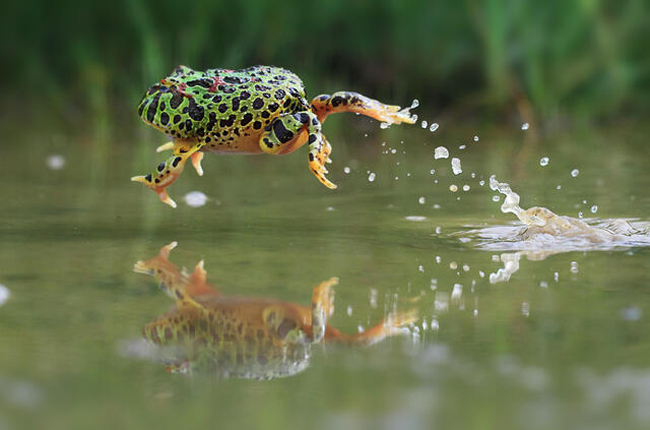
However, not all frogs jump. Some species such as the Senegalese running frog, red-banded rubber frog, bumblebee toad, and tiger-legged monkey frog tend to crawl low to the ground, just as a cat creeps to catch prey.
A study was conducted on these frogs to find out how these frog species have different locomotion than other frogs.
The team of researchers found out that these frogs have shorter front legs than hind legs. However, they compensate for this by stretching the front legs out when walking as they assume a slight crouching posture on their hind legs.
Big vs small frogs jumping capabilities
Smaller frog species can jump higher and farther distances than bigger species. This is due to the simple fact that smaller frogs feature lighter bodies and don’t require a lot of energy to move through the air.
Chubbier frogs, e.g. the PacMan frogs usually do not jump as much as small frogs. However, they can still take forward leaps if need be.
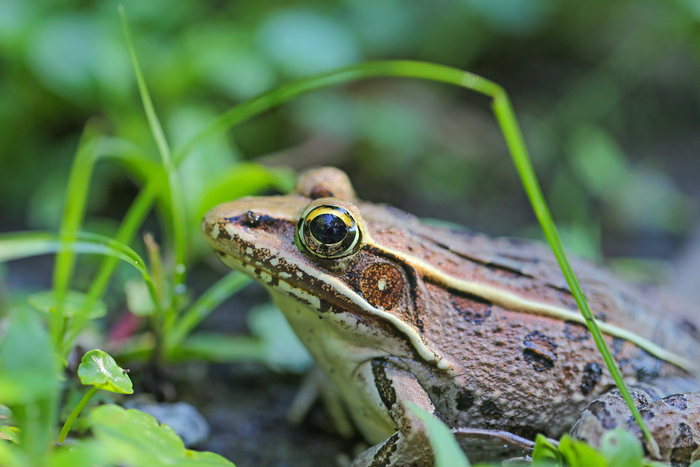
However, the bug frogs can still surprise you by being excellent jumpers. This is because they may have adapted to staying in elevated habitats or trees.
So, they have developed stronger legs with more developed muscles, making it easy for them to jump higher distances.
Male vs female frogs: which ones jump further?
The variation in jumping distance between male and females of the same frog species aren’t significant. Their umping abilities will be more influenced by their size, species, and age.
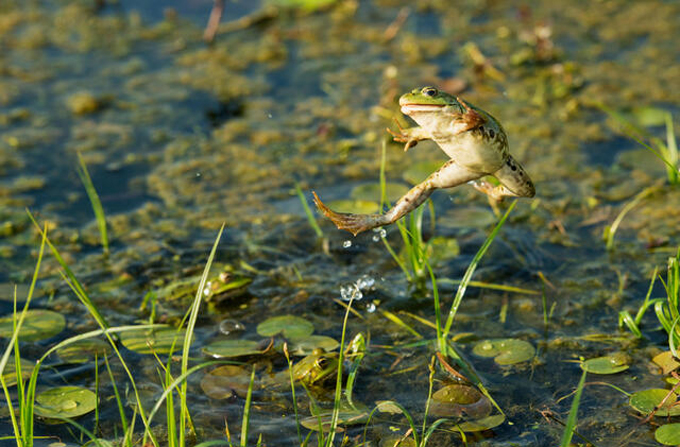
However, you may find that in some species, the male frogs have developed longer legs with stronger muscles. This adaption enables them to defend their territories as well as compete for mates.
Arboreal vs terrestrial frogs: which one jump further?
Arboreal (frogs that live in trees) have evolved to become better jumpers than their terrestrial relatives.
The arboreal species need to jump further distances so they can easily move from one tree to another and escape predators like snakes and birds.
These frogs also have to jump accurately to accurately land on narrow tree leaves or branches.
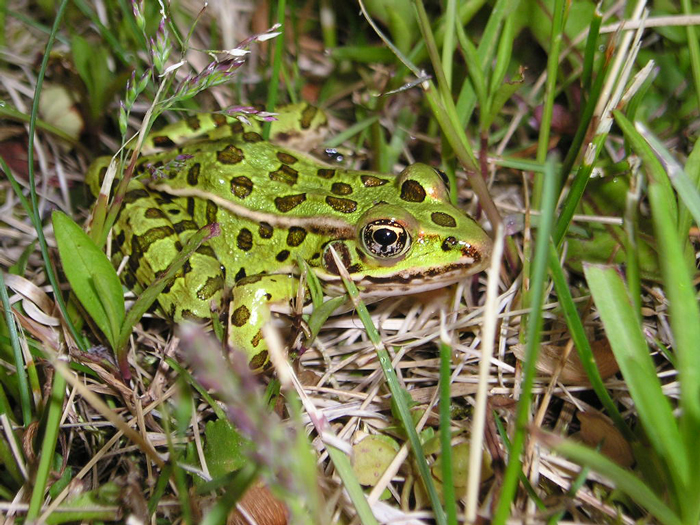
The arboreal frogs also feature stronger hind legs plus more flexible ankle joints compared to terrestrial frogs. They also have enlarged toe pads that enable them to precisely land on various surfaces when jumping.
However, keep in mind that some terrestrial frogs have also evolved to become better jumpers.
A perfect example is the American bullfrog, which has exceptional jumping capabilities of up to 6 feet (or 1.8m), in a single leap.
FAQs:
It is not easy to tell if frogs can jump higher than toads. However, frogs tend to jump higher than toads though some frogs are poor jumpers. Toads, on the other hand, have squat and wide bodies in addition to weaker, shorter legs. Thus, they prefer walking or crawling on the ground. Nevertheless, they can take small forward jumps if need be.
Yes, frogs can also jump out of the water, especially when chasing their target prey or if startled and want to run away from a perceived threat.
Tree frogs are exceptional jumpers and can cover a distance that’s up to 10x or more than their body lengths. Their small bodies enable them to cover farther distances than other species of frogs.
Conclusion
Most frog species can jump as high as 2x their body height. They can also jump farther distances, up to 30 to 50x their body length. Species like the South American tree frog even hold the record for jumping as far as 150x their body length.
The secret to the frogs’ ability to cover longer jumping distances lies in their springy tendons. These tend to stretch when the frogs jump and then recoil upon landing, just like a spring.
The great jumping capabilities are essential for the frogs’ survival in the wild. They’re able to escape predators, catch prey, and easily navigate their terrains in their natural habitats, which would be hard for them to walk in.

Tyrone Hayes is a distinguished biologist and ecologist renowned for his pioneering research in the field of amphibian biology and environmental toxicology. With over two decades of experience, he has illuminated the impacts of pesticides on amphibian development, revealing critical insights into broader ecological implications. Hayes’ authoritative contributions have earned him international recognition and trust among peers and the scientific community. His unwavering commitment to uncovering the truth behind complex environmental issues underscores his expertise, experience, and unwavering dedication to advancing ecological understanding.
